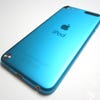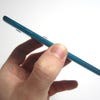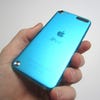Fifth Gen iPod Touch review
Is there still room in the market for iPhone's little brother? Digital Foundry finds out.
Given Apple's intense focus on the iPhone and iPad - not to mention the newly-announced iPad mini - you'd be forgiven for assuming that the iPod Touch has been reduced to little more than an afterthought; a relic from an era when people insisted on carrying around dedicated music players along with their mobile phones.
However, the release of the fifth-generation model of the Touch makes it clear that Apple doesn't see things that way - this revised edition is possibly the most impressive upgrade the iPod Touch line has witnessed since its inception alongside the original iPhone way back in 2007. However, at £250 for the 32GB model this isn't a cheap option, nor does it offer complete parity with the impressive iPhone 5. This is a last-gen processor in a current-gen shell.
It's almost a given that a device like the iPod Touch is going to be thin, but irrespective of your preconceived ideas of what its dimensions are likely to be, nothing can really prepare you for the moment you unclip the unit from its all-plastic packaging and cradle it in the palm of your hand. With a thickness of just over 6mm, this is one seriously svelte piece of tech. Thankfully, due to the metal unibody construction it never feels like you're going to snap it in half.
Design cues have naturally been taken from the iPhone 5, but the latest iPod is still infused with its own personality. The rounded edges ensure it sits comfortably in the hand, and the colourful range of case hues - white, slate (black), pink, yellow, and cyan - allow potential owners to stand out from their iPhone-owning buddies. All of the colour choices come with white bezels around the screen, with the exception of the slate - while it's naturally a case of personal preference, we couldn't help but feel that a black surround makes a classier impression.
The new iPod brings with it several fresh features, the most obvious of which is the new Lightning port at the bottom of the device. Significantly smaller than the previous 30-pin standard Apple connector, it comes with both good and bad points.
On the plus side, it's impossible to insert it the wrong way around - the pins are present on both sides of the connection lead. Unfortunately, a new connection standard means that your new iPod isn't compatible with the thousands of iPod docks located in the living rooms all over the world, although Apple has offered adapters to overcome this issue - but even here, compatibility is limited. It also means that your old USB cables won't work, either.
Another big 'innovation' is the pop-up lanyard clip, to which you can attach the bundled 'loop' accessory - Apple's fancy name for what is little more than wrist strap. While we're all in favour of providing additional security for devices like this one, the loop is unlikely to endear itself to many users in the long-run. It's fiddly to attach and just gets in the way during use. We'd be willing to wager that the vast majority of these straps will remain unused in the packaging.
Finally, we have the Apple EarPods - the first major revision of those signature white bundled headphones in years. According to the marketing speak, Apple's engineers tested 124 different prototypes on over 600 people's lug holes before settling on the final design, but to be brutally honest the difference is negligible. Like almost every single pair of headphones included with a device free of charge, the EarPods are no match for a premium pair of cans. If you're serious about enjoying your audio on the move, you're unlikely to endure the passable but average sound produced by these headphones.
Power and performance: an iPhone 4S in different clothing
Despite being announced around the same time as the iPhone 5, the fifth-generation iPod Touch has more in common from a technical perspective - larger screen excepted - with the iPhone 4S. It's powered by the same Apple A5 SoC - comprised of a dual-core ARM Cortex A9 CPU and a PowerVR SGX543 MP2 graphics processor. Performance is generally comparable, although the A5 is having to push more pixels this time around, thanks to that larger 4-inch 1136x640 pixel IPS display.
Aside from the ability to make phone calls and use telephone networks to send and receive data, the fifth-gen iPod Touch offers the same functionality as the iPhone 5. For the first time, Siri has made the jump to the Touch, although the usefulness of Apple's much-hyped personal assistant is curtailed by the fact that it requires a data connection to function - something which isn't guaranteed on a 3G-less device like the iPod. If you want to ask Siri a question, you'll need to be within range of an open WiFi hotspot or tethered to a device with wireless connectivity.
"Aside from the ability to make phone calls and use telephone networks to send and receive data, the Fifth Gen iPod Touch offers the same features as the iPhone 5."
iOS 6 is pre-installed as standard, which means users benefit from a raft of improvements which were previously introduced when the software went live with the release of the iPhone 5. The aforementioned Siri has become smarter, and is now able to comment on sports results (American ones only, unfortunately) as well as provide information culled from the likes of Yelp. Siri can also chat about aspects of Hollywood movies, assuming you're lacking a real human to converse with on such a topic.
Facebook integration is neat, but shows just how far behind Google Apple is in this regard - the ability to share information between the OS and applications has been part of Android's framework for years. More useful is the 'Do Not Disturb' function, which automatically shuts down notifications during a predetermined time period - when you're asleep, for example.
Slightly less welcome is Apple's new Maps app, which takes over from where Google Maps (now expunged from iOS, like several other Google offerings) left off - only that it doesn't do that convincing a job. As has been publicised comprehensively elsewhere online, Apple Maps is riddled with mistakes and feels like a pre-beta product - something which has already caused the company much embarrassment, and no doubt brought a smile to the face of many an executive at Google.
Improvements aside, iOS is starting to look a little tired now. The familiar grid arrangement feels like a relic from the past, especially when compared to the widget-packed Android home screen and Windows Phone's vibrant active tiles. Of course, the trade-off is dependability - iOS on the new iPod Touch is as smooth as silk and boasts a responsiveness and stability that Android can only dream of, even on the latest quad-core handsets.
Can the new Touch replace a digital camera?
The iPod Touch's camera has also been given a specification bump, with the fourth gen's 960x720 pixel camera replaced by an iSight 5-megapixel variant. The front-facing snapper has also grown in stature, now able to capture images at 1.2 megapixels. Video recording tells a similar story; the rear-facing camera on the Touch captures 30FPS footage at 1080p, although it has to be said that the results aren't as impressive as you might imagine. The front camera can record in HD also, but it's 720p and predictably underwhelming.
"Apple positions the Touch as a camera replacement, but while the optics are decent, the LED flash is weak and the tiny sensor is no match for a decent point and shoot snapper."




Despite Apple's assurances that this is the first iPod Touch that can legitimately usurp your dedicated point-and-shoot camera, the quality of the images isn't as breathtaking as the hyperbole would have you believe.
Detail is decent and colours are replicated with impressive accuracy, but the LED flash is weak unless you're very close to your subject, and the small camera sensor means that most average digital cameras will out-perform the iPod Touch when it comes to photography. Still, it's a welcome bonus, especially when you remember that not so long ago, such functionality was completely absent on the iPod Touch.
Gaming on the iPod Touch
So just how much gaming horsepower does the fifth-gen iPod Touch pack into that miniscule chassis? We decided to put its power into context by drawing upon some of the benchmarking we did for our iPhone 5 review and factoring the new Touch into the equation. Browser tests with SunSpider and Rightware Browsermark give us some perspective on CPU prowess, while a brace of GL Benchmark 2.1 metrics put GPU power into context. The results strongly indicate that this is a full-blooded A5 device that packs an almost identical level of power to the 4S. OS performance is a match, browsing speed likewise and gaming frame-rates - on non-widescreen games at least - should be identical.
"Benchmarks confirm iPhone 4S performance levels - good enough by today's standards but only half as fast as the recently released iPhone 5."
| Fifth Gen iPod Touch | iPhone 4 | iPhone 4S | Third Gen iPad | iPhone 5 | |
|---|---|---|---|---|---|
| SunSpider Javascript 0.9.1 (lower is better) | 1838.7ms | 2972.2ms | 1800.3ms | 1566.0ms | 993.5ms |
| Rightware Browsermark | 102864 | 59495 | 105464 | 126979 | 192460 |
| GL Benchmark 2.1 Egypt (720p Offscreen) | 71FPS | 11FPS | 72FPS | 123FPS | 146FPS |
| GL Benchmark 2.1 Pro (720p Offscreen) | 119FPS | 17FPS | 120FPS | 236FPS | 252FPS |
Apple's proud boast of providing 'console quality' gaming on the iPhone 5 may have little credibility at present, but with the likes of Real Racing 3 promising some impressive visuals for a portable platform, the claims perhaps have some merit on the way. But we have to remember that the Touch isn't running the latest A6 processor, it's still using last year's A5, which offers around half the raw performance. We see two different scenarios playing out in the medium to long term.
Firstly, developers could push themselves to take full advantage of the iPhone 5's impressive specifications, and that means the new iPod Touch is likely to be left behind somewhat. Alternatively, it may well be the case that developers will seek out the critical mass of devices out there: iPad 2, iPad mini, iPhone 4S and this new Touch all use the same A5 architecture making it a good target for baseline game performance.
But even in this best-case scenario, we still have some concerns. The new Touch has an 18 per cent increase in screen resolution compared to the iPhone 4S and as the specs demonstrate, there's no boost in performance to make up the difference. While resolution of the new screen - in terms of raw pixel count - is approaching that of the A5-packing iPad 2, Apple runs that particular iteration of the processor at 1GHz, while the Touch runs at 800MHz, just like the 4S.
Suffice to say that while this device may feature the same display tech as the iPhone 5, the new Touch trails the pace-setting new mobile handset by a considerable margin. This naturally impacts the iPod Touch's ability to host the latest and greatest 3D games; this isn't so much of an issue at present, but it's worth factoring into the buying decision.
"The new Touch has an 18 per cent increase in screen resolution compared to the iPhone 4S and, as the specs demonstrate, there's no boost in performance to make up the difference."
Fifth Gen iPod Touch: the Digital Foundry verdict
It's difficult to judge just how successful an update the fifth-generation iPod Touch really is. When compared to the previous model, the improvements are dramatic - superior processing power, better graphical performance and a larger screen all contribute to the feeling that this is a significant step up from its immediate predecessor.
The problem is that the iPod Touch is based in no small part on the iPhone 5 - it shares the same screen size and resolution and is running the same OS. In fact, it's essentially the iPhone 5 but minus the ability to make telephones calls. It could be argued that this has been the case with the iPod Touch range since day one, but with the device now gaining parity in terms of software and features (say hello to Siri), it's never been more true than it is now.
Therein lies the problem; while the Fifth Gen iPod Touch wants to emulate its bigger brother, it's been given weaker internal tech. The A5 is still a capable chipset - as anyone with an iPhone 4S will attest - but it's going to need to do more legwork here thanks to that enhanced screen. The current generation of games plays fine, but titles like Real Racing 3 are providing a tantalising glimpse of what the next 12 months could hold for mobile gaming - and our fear is that the new iPod Touch could well find itself struggling to keep up.
"As a pure games machine the price-point of the Touch is somewhat hard to handle when the iPad mini is just £20 more with the Nexus 7 almost £100 less expensive."
Another sticking point is the price - at £250, this is not a product that finds itself located in impulse purchase territory. Previous models have always offered an entry point under the £200 mark, but with the removal of a cheaper 16GB variant (32GB is now the entry point), Apple has raised the price of admission.
The viability of the iPod Touch is made even more questionable by the announcement of the iPad mini, a 7.9-inch tablet which starts from £269 - just £20 more than the iPod Touch - and also uses the Apple A5 chipset. Chances are that it's also running that tech at the same 1GHz as the iPad 2, giving it a 20 per cent performance boost over the new Touch. You also have to ask yourself if you're not just better off stumping up a little extra cash for a second-hand or refurbished iPhone 4S - while you'll have to make do with a smaller screen, you'll obviously have all the phone and GPS functionality too.
Steve Jobs once dubbed the iPod Touch "training wheels for the iPhone" and a great many of these devices have found their way into the hands of young users, too financially dependant on their parents to entertain the idea of getting an iPhone. With the higher retail price, the fifth-generation Touch could well be pricing itself out of the market; when looking for that all-in-one device which plays music and games, the cheaper 3DS and Vita could appear to be better choices - and when you consider that you can purchase a Nexus 7 tablet for almost £100 less, the iPod Touch becomes even less of an essential item.






















































